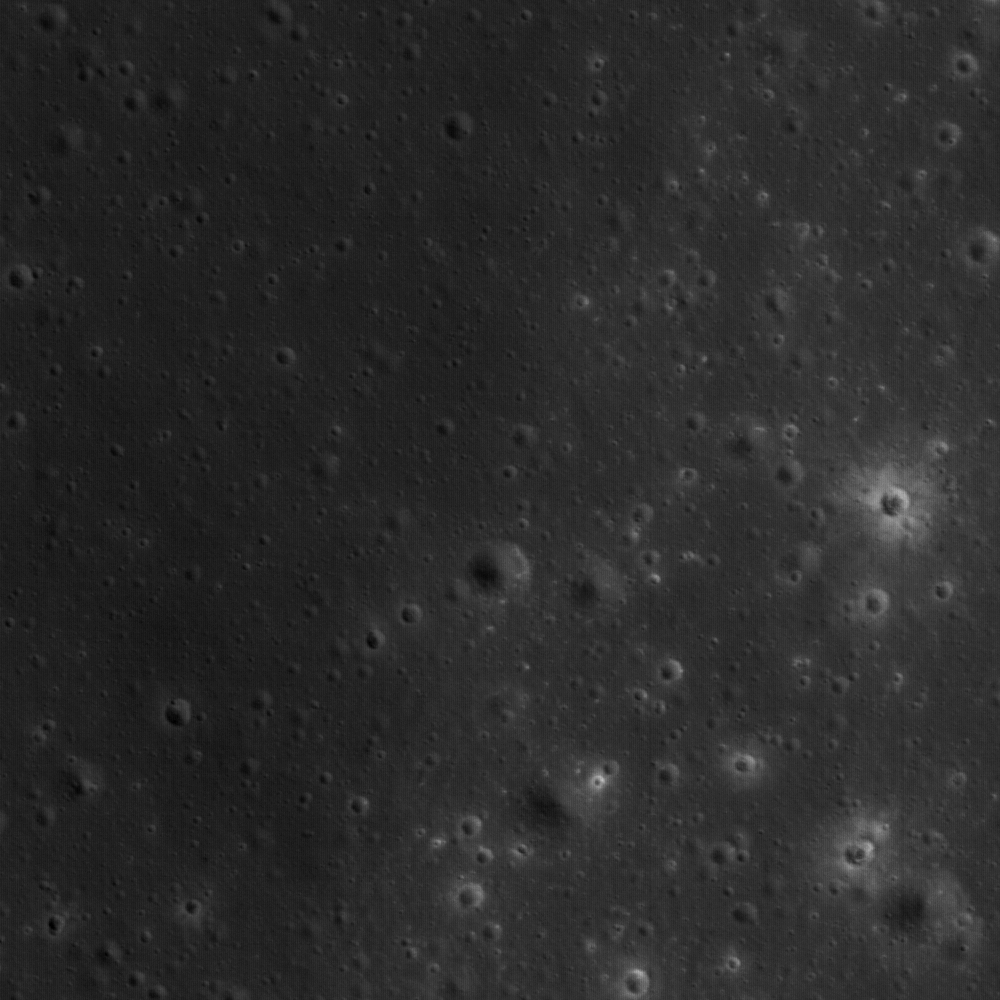Featured Images

Intricate young ejecta blanket in ancient Murchison Crater
Overlapping petals of bright ejecta illustrate the complexity of ejecta emplacement, even in smaller impact events. The source crater is ~120 meters in diameter and lies on the floor of Murchison Crater, one of the Constellation...
Published on 09 Feb 2010

Riccioli Crater: Cracked, Melted, and Draped
High-resolution LROC view of part of the floor of Riccioli Crater, near the center of the Constellation region of interest. The view is centered on the boundary between a spur of the crater's central peak materials (lower right half of...
Published on 04 Feb 2010

Out of the Shadows: Impact Melt Flow at Byrgius A Crater
Spectacularly preserved viscous flow on the NE rim of Byrgius A (19 km diameter) crater. This flow has a form similar to lava flows on the Earth - however it formed as a result of an asteroid or comet slamming into the Moon at...
Published on 02 Feb 2010

Plato Crater Constellation Region of Interest
The Constellation Program region of interest northwest of Plato crater exhibits a wide variety of geologic features. LROC WAC frame M109269483CE; 695 nm in red, 567 nm in green, 415 nm in blue [NASA/GSFC/Arizona State University].
Published on 02 Feb 2010

Precise 3D Measurements of Objects at Apollo 14 Landing Site from LROC NAC Stereo Images
Can we measure the size and shape of equipment and other objects on the Moon using today’s orbital images from LROC cameras? As an example, to demonstrate the precise 3D measurement capability of LROC NAC stereo imagery, three objects...
Published on 29 Jan 2010

Montes Pyrenaeus meets Mare Nectaris
A contact between the dark basalt (left) of Mare Nectaris and the lighter anorthosite highlands (right) of Montes Pyrenaeus runs through the Constellation Program region of interest on the western rim of the Nectaris impact basin. ...
Published on 28 Jan 2010

King Crater's Unusual Melt Pond
A Constellation Program Region of Interest near the northeast edge of the unusually large melt pond adjacent to the lunar far side crater King. The boundary between the dark, coherent impact melt rock at the lower left of the image and...
Published on 26 Jan 2010

Aristarchus Plateau (2): Pyroclastic Deposit
NAC Frame M111945148R. Part of the vast pyroclastic deposit near a Constellation Program Region of Interest located on the Aristarchus plateau is visible in this image. View is 537 m across [NASA/GSFC/Arizona State University].
Published on 21 Jan 2010

A Digital Terrain Model of the Orientale Basin
A Digital Terrain Model (DTM) of the large Orientale Basin (1100 km diameter), located on the western hemisphere of the Moon, produced from stereo LROC WAC images. The image shows the hill-shaded, color-coded DTM with heights varying...
Published on 20 Jan 2010

Aristarchus Plateau (1): Amazing Geologic Diversity
Eastern slope (right to left is downhill) of the Vallis Schröteri, "Cobra Head". This feature is located in the western portion of a Constellation Program region of interest on the Aristarchus plateau. The slopes of the Cobra Head are...
Published on 19 Jan 2010

The Floor of Tycho - Constellation Region of Interest
Boulders and impact melt line the floor of the 85-km crater Tycho, a potential site for future human exploration. Scene width is 620 m [NASA/GSFC/Arizona State University].
Published on 14 Jan 2010

Aitken Crater Constellation Program Region of Interest
A lobate scarp in the mare basalts of Aitken crater on the lunar farside (arrows). Aitken crater is one of the fifty regions of interest in NASA’s Constellation Program. The smooth mare basalts that flooded the floor of Aitken crater...
Published on 12 Jan 2010

Mare Moscoviense Constellation Site
A very subtle mare-highlands boundary in Mare Moscoviense on the lunar farside, near the center of the Constellation Program region of interest. The generalized geologic contact between the mare and the highlands has been highlighted...
Published on 04 Jan 2010

Wrinkle Ridge Near Montes Teneriffe
Boulders perched atop a wrinkle ridge in Mare Imbrium west of the Montes Teneriffe. Image width is 2 km, NAC frame M102264014RE [NASA/GSFC/Arizona State University].
Published on 29 Dec 2009

Peary Crater: Greetings from the North Pole of the Moon
A junction between the rims of three craters on the floor of Peary crater near the lunar north pole is evident in this NAC image (M101955359L). Note the mottled texture of the regolith. Peary is a key exploration site for future...
Published on 24 Dec 2009

Moon or Abstract Expressionism?
Seeing small areas of the Moon at 50 cm per pixel often presents unexpected views, and sometimes it is hard to interpret the geology at first glance, much less what is up and what is down! What are the white streaks? How did they get...
Published on 22 Dec 2009

Fresh Copernican Crater
Subset of NAC Image M112162602L showing landslides (bottom) covering impact melt on the floor (top) of a fresh Copernican-age crater at the edge of Oceanus Procellarum and west of Balboa crater. Image width is 550 m [NASA/GSFC/Arizona...
Published on 21 Dec 2009

Vallis Alpes
A bottleneck at the start of the lunar sinuous rille within Vallis Alpes formed several morphologic features including (from left to right) a lava pond, a breached dam, and an island in the rille. Image width is 3.3 km, image resolution...
Published on 17 Dec 2009

Pull Apart - Grabens
Graben are common extensional features on the Moon as well as the other terrestrial planets and icy satellites. This graben (700 m wide) formed within a larger graben (1700 m). Illumination is the from the left (NASA/GSFC/Arizona State...
Published on 16 Dec 2009

Impact Melt Flows on Giordano Bruno
Frozen impact melt flows on the ejecta blanket of the young impact crater Giordano Bruno (22 km diameter). The image is about 600 m across and the flows are about 50-100 m wide (NASA/GSFC/Arizona State University).
Published on 15 Dec 2009